Second-Life Batteries: A Review on Power Grid Applications, Degradation Mechanisms, and Power Electronics Interface Architectures
Abstract
:1. Introduction
2. Second-Life Battery Market
2.1. SLB Players in the USA Market
2.2. SLB Players in the Global Market
3. Degradation Mechanisms and State-of-Health (SOH) Estimation of Second-Life Batteries
3.1. Degradation Mechanisms
3.1.1. Solid Electrolyte Interface (SEI) Growth
3.1.2. Lithium Plating
3.1.3. Particle Fracture
3.1.4. Other Degradation Mechanisms
3.2. State-of-Health (SOH) Estimation for SLBs
4. Applications of Second-Life Batteries in Electrical Grids
4.1. Power Smoothing
4.2. Peak Shaving
4.3. Energy Arbitrage
4.4. Frequency Containment Reserve (FCR) Service
5. Power Electronics Interface for Second-Life Batteries
5.1. Power Processing Architectures
5.2. Reliability
5.2.1. Single-Stage Converter
5.2.2. Two-Stage Converter
5.2.3. Two-Stage Topology with Redundant Cell Mechanism
5.2.4. Three-Stage Converter
5.2.5. Cascaded Multilevel Converter
5.2.6. DC-DC Converter Integrated Cascaded Multilevel Converter
6. Battery Management System (BMS) for Second Life Batteries (SLBs)
7. Discussion
8. Conclusions
Author Contributions
Funding
Data Availability Statement
Conflicts of Interest
Nomenclature
| battery energy storage system | |
| battery management system | |
| conventional power processing | |
| energy arbitrage | |
| end of life | |
| enhanced single-particle model | |
| full power processing | |
| frequency regulation | |
| internal combustion engine | |
| LS-HiPP | lite-sparse hierarchical partial processing |
| mixed least-squares estimator ramp-rate compliant | |
| solid electrolyte interface | |
| SLB | second-life battery |
| second-life battery energy storage system | |
| state of health | |
| single-particle model | |
| time of use | |
| individual cell reliability | |
| reliability of DC-AC converter | |
| reliability of filter stage | |
| total reliability | |
| reliability function of a system considered to have k-out-of-m redundancy if there are ‘n’ number of modules in them | |
| individual reliability of the power stage | |
| reliability of the overall module |
References
- IEA. Global EV Outlook 2023; Technical Report; IEA: Paris, France, 2023; Available online: https://www.iea.org/reports/global-ev-outlook-2023 (accessed on 3 October 2023).
- Engel, H.; Hertzke, P.; Siccardo, G. Second-Life EV Batteries: The Newest Value Pool in Energy Storage; McKinsey & Company: Chicago, IL, USA, 2019. [Google Scholar]
- Zhu, J.; Mathews, I.; Ren, D.; Li, W.; Cogswell, D.; Xing, B.; Sedlatschek, T.; Kantareddy, S.N.R.; Yi, M.; Gao, T.; et al. End-of-life or second-life options for retired electric vehicle batteries. Cell Rep. Phys. Sci. 2021, 2, 100537. [Google Scholar] [CrossRef]
- IEA. The Role of Critical Minerals in Clean Energy Transitions; IEA: Paris, France, 2021. [Google Scholar]
- Chen, M.; Ma, X.; Chen, B.; Arsenault, R.; Karlson, P.; Simon, N.; Wang, Y. Recycling end-of-life electric vehicle lithium-ion batteries. Joule 2019, 3, 2622–2646. [Google Scholar] [CrossRef]
- Faessler, B. Stationary, second use battery energy storage systems and their applications: A research review. Energies 2021, 14, 2335. [Google Scholar] [CrossRef]
- Deng, Y.; Zhang, Y.; Luo, F.; Mu, Y. Operational Planning of Centralized Charging Stations Utilizing Second-Life Battery Energy Storage Systems. IEEE Trans. Sustain. Energy 2021, 12, 387–399. [Google Scholar] [CrossRef]
- Salek, F.; Morrey, D.; Henshall, P.; Resalati, S. Techno-Economic Assessment of Utilising Second-Life Batteries in Electric Vehicle Charging Stations; Technical Report, SAE Technical Paper; SAE International: Warren, PA, USA, 2023. [Google Scholar]
- Shahjalal, M.; Roy, P.K.; Shams, T.; Fly, A.; Chowdhury, J.I.; Ahmed, M.R.; Liu, K. A review on second-life of Li-ion batteries: Prospects, challenges, and issues. Energy 2022, 241, 122881. [Google Scholar] [CrossRef]
- Khan, S.A.; Wang, M.; Su, W.; Liu, G.; Chaturvedi, S. Grid-Forming Converters for Stability Issues in Future Power Grids. Energies 2022, 15, 4937. [Google Scholar] [CrossRef]
- Hu, X.; Deng, X.; Wang, F.; Deng, Z.; Lin, X.; Teodorescu, R.; Pecht, M.G. A review of second-life lithium-ion batteries for stationary energy storage applications. Proc. IEEE 2022, 110, 735–753. [Google Scholar] [CrossRef]
- Hassan, A.; Altin, M.; Bingöl, F. Inertia and droop controller for a modern variable speed wind turbine to provide frequency control in a microgrid. Politek. Derg. 2020, 23, 771–777. [Google Scholar] [CrossRef]
- Zhang, D.; Li, J.; Hui, D. Coordinated control for voltage regulation of distribution network voltage regulation by distributed energy storage systems. Prot. Control Mod. Power Syst. 2018, 3, 1–8. [Google Scholar] [CrossRef]
- Wang, G.; Ciobotaru, M.; Agelidis, V.G. Power smoothing of large solar PV plant using hybrid energy storage. IEEE Trans. Sustain. Energy 2014, 5, 834–842. [Google Scholar] [CrossRef]
- Chua, K.H.; Lim, Y.S.; Morris, S. Energy storage system for peak shaving. Int. J. Energy Sect. Manag. 2016, 10, 3–18. [Google Scholar] [CrossRef]
- Khan, S.A. Unified voltage droop control strategy for VSC-MTDC in HVDC system. In Proceedings of the 16th IET International Conference on AC and DC Power Transmission (ACDC 2020), Online, 2–3 July 2020; IET Conference Proceedings; pp. 846–851. [Google Scholar]
- Hagiwara, M.; Akagi, H. Experiment and Simulation of a Modular Push–Pull PWM Converter for a Battery Energy Storage System. IEEE Trans. Ind. Appl. 2014, 50, 1131–1140. [Google Scholar] [CrossRef]
- Soong, T.; Lehn, P. Evaluation of Emerging Modular Multilevel Converters for BESS Applications. IEEE Trans. Power Deliv. 2014, 29, 2086–2094. [Google Scholar] [CrossRef]
- Vasiladiotis, M.; Rufer, A. Analysis and Control of Modular Multilevel Converters With Integrated Battery Energy Storage. IEEE Trans. Power Electron. 2015, 30, 163–175. [Google Scholar] [CrossRef]
- Chaturvedi, S.; Wang, M.; Fan, Y.; Fulwani, D.; Hollweg, G.V.; Khan, S.A.; Su, W. Control Methodologies to Mitigate and Regulate Second-Order Ripples in DC–AC Conversions and Microgrids: A Brief Review. Energies 2023, 16, 817. [Google Scholar] [CrossRef]
- Hollweg, G.V.; Khan, S.A.; Chaturvedi, S.; Fan, Y.; Wang, M.; Su, W. Grid-Connected Converters: A Brief Survey of Topologies, Output Filters, Current Control, and Weak Grids Operation. Energies 2023, 16, 3611. [Google Scholar] [CrossRef]
- Mukherjee, N.; Strickland, D. Second life battery energy storage systems: Converter topology and redundancy selection. In Proceedings of the 7th IET International Conference on Power Electronics, Machines and Drives (PEMD 2014), Manchester, UK, 8–10 April 2014; IET: Stevenage, UK, 2014; pp. 1–6. [Google Scholar]
- Birkl, C.R.; Frost, D.F.; Bizeray, A.M.; Richardson, R.R.; Howey, D.A. Modular converter system for low-cost off-grid energy storage using second life li-ion batteries. In Proceedings of the IEEE Global Humanitarian Technology Conference (GHTC 2014), San Jose, CA, USA, 10–13 October 2014; pp. 192–199. [Google Scholar] [CrossRef]
- Mukherjee, N.; Strickland, D.; Varnosfaderani, M.A. Adaptive Control of Hybrid Battery Energy Storage Systems under Capacity Fade. EPE J. 2015, 25, 25–33. [Google Scholar] [CrossRef]
- Mukherjee, N.; Strickland, D. Control of second-life hybrid battery energy storage system based on modular boost-multilevel buck converter. IEEE Trans. Ind. Electron. 2014, 62, 1034–1046. [Google Scholar] [CrossRef]
- Chen, G.; Burgos, R.; Liang, Z.; Lacaux, F.; Wang, F.; Van Wyk, J.; Odendaal, W.; Boroyevich, D. Reliability-oriented design considerations for high-power converter modules. In Proceedings of the 2004 IEEE 35th Annual Power Electronics Specialists Conference (IEEE Cat. No. 04CH37551), Aachen, Germany, 20–25 June 2004; IEEE: Piscataway, NJ, USA, 2004; Volume 1, pp. 419–425. [Google Scholar]
- Julian, A.L.; Oriti, G. A Comparison of Redundant Inverter Topologies to Improve Voltage Source Inverter Reliability. IEEE Trans. Ind. Appl. 2007, 43, 1371–1378. [Google Scholar] [CrossRef]
- Ding, Y.; Loh, P.C.; Tan, K.K.; Wang, P.; Gao, F. Reliability evaluation of three-level inverters. In Proceedings of the 2010 Twenty-Fifth Annual IEEE Applied Power Electronics Conference and Exposition (APEC), Palm Springs, CA, USA, 21–25 February 2010; pp. 1555–1560. [Google Scholar] [CrossRef]
- Beg, O.A.; Khan, A.A.; Rehman, W.U.; Hassan, A. A Review of AI-Based Cyber-Attack Detection and Mitigation in Microgrids. Energies 2023, 16, 7644. [Google Scholar] [CrossRef]
- Williams, B.; Lipman, T. Analysis of the Combined Vehicle-Use Value of Lithium-Ion Plug-In-Vehicle Propulsion Batteries. Task 3, Second Life Applications and Value of ‘Traction’Lithium Batteries; Transportation Sustainability Research Center, University of California: Berkeley, CA, USA, 2011. [Google Scholar]
- Neubauer, J.; Pesaran, A. The ability of battery second use strategies to impact plug-in electric vehicle prices and serve utility energy storage applications. J. Power Sources 2011, 196, 10351–10358. [Google Scholar] [CrossRef]
- Mathews, I.; Xu, B.; He, W.; Barreto, V.; Buonassisi, T.; Peters, I.M. Technoeconomic model of second-life batteries for utility-scale solar considering calendar and cycle aging. Appl. Energy 2020, 269, 115127. [Google Scholar] [CrossRef]
- Bipartisan Infrastructure Law Electric Drive Vehicle Battery Recycling and Second Life Applications Funding Opportunity Announcement; Department of Energy: Washington, DC, USA, 2023.
- Hadjipaschalis, I.; Poullikkas, A.; Efthymiou, V. The role of second-life batteries in the energy storage revolution. Energy Sci. Eng. 2017, 5, 363–388. [Google Scholar]
- van Nieuwenhuijsen, W.A.; Heijman, H.J. Second-life batteries for electric vehicles: A review of commercialization and research trends. Appl. Energy 2022, 301, 1175–1189. [Google Scholar]
- NMSC. Second-Life EV Battery Market by Battery Type (Lead Acid Battery, Nickel Metal Hydride Battery, and Lithium Ion Battery) by Battery Source (Two Wheelers, Electric Buses, Electric Cars, and Others) and by Application (Residential, on-Grid, off-Grid, and Mobile)—Global Opportunity Analysis and Industry Forecast 2021–2030; 2023. Available online: https://www.nextmsc.com/report/second-life-ev-battery-market (accessed on 3 October 2023).
- Hassan, A. Frequency Control in an Isolated Power System with High Penetration of Wind Power. Available online: https://www.proquest.com/openview/d838d0ba176bc4c8fa823461ab64f2ea/1?pq-origsite=gscholar&cbl=2026366&diss=y (accessed on 3 October 2023).
- Rohr, S.; Müller, S.; Baumann, M.; Kerler, M.; Ebert, F.; Kaden, D.; Lienkamp, M. Quantifying Uncertainties in Reusing Lithium-Ion Batteries from Electric Vehicles. Procedia Manuf. 2017, 8, 603–610. [Google Scholar] [CrossRef]
- Wang, Z.; Al Alwan, B.; Ng, K.S. Multi-functions of amino thiophenol additives for shielding lithium metal anode in advanced Li-S battery. Mater. Sci. Eng. B 2023, 297, 116727. [Google Scholar] [CrossRef]
- Single, F.; Latz, A.; Horstmann, B. Identifying the Mechanism of Continued Growth of the Solid–Electrolyte Interphase. ChemSusChem 2018, 11, 1950–1955. [Google Scholar] [CrossRef]
- Ploehn, H.J.; Ramadass, P.; White, R.E. Solvent Diffusion Model for Aging of Lithium-Ion Battery Cells. J. Electrochem. Soc. 2004, 151, A456. [Google Scholar] [CrossRef]
- Pinson, M.B.; Bazant, M.Z. Theory of SEI Formation in Rechargeable Batteries: Capacity Fade, Accelerated Aging and Lifetime Prediction. J. Electrochem. Soc. 2013, 160, A243–A250. [Google Scholar] [CrossRef]
- Li, D.; Danilov, D.; Zhang, Z.; Chen, H.; Yang, Y.; Notten, P.H.L. Modeling the SEI-Formation on Graphite Electrodes in LiFePO 4 Batteries. J. Electrochem. Soc. 2015, 162, A858–A869. [Google Scholar] [CrossRef]
- Tang, M.; Lu, S.; Newman, J. Experimental and Theoretical Investigation of Solid-Electrolyte-Interphase Formation Mechanisms on Glassy Carbon. J. Electrochem. Soc. 2012, 159, A1775–A1785. [Google Scholar] [CrossRef]
- Broussely, M.; Herreyre, S.; Biensan, P.; Kasztejna, P.; Nechev, K.; Staniewicz, R.J. Aging mechanism in Li ion cells and calendar life predictions. J. Power Sources 2001, 97, 13–21. [Google Scholar] [CrossRef]
- Röder, F.; Braatz, R.D.; Krewer, U. Multi-Scale Simulation of Heterogeneous Surface Film Growth Mechanisms in Lithium-Ion Batteries. J. Electrochem. Soc. 2017, 164, E3335–E3344. [Google Scholar] [CrossRef]
- Single, F.; Horstmann, B.; Latz, A. Revealing SEI Morphology: In-Depth Analysis of a Modeling Approach. J. Electrochem. Soc. 2017, 164, E3132–E3145. [Google Scholar] [CrossRef]
- Single, F.; Horstmann, B.; Latz, A. Dynamics and morphology of solid electrolyte interphase (SEI). Phys. Chem. Chem. Phys. 2016, 18, 17810–17814. [Google Scholar] [CrossRef]
- Shi, S.; Lu, P.; Liu, Z.; Qi, Y.; Hector Jr, L.G.; Li, H.; Harris, S.J. Direct calculation of Li-ion transport in the solid electrolyte interphase. J. Am. Chem. Soc. 2012, 134, 15476–15487. [Google Scholar] [CrossRef]
- Soto, F.A.; Ma, Y.; Hoz, J.M.M.D.L.; Seminario, J.M.; Balbuena, P.B. Formation and Growth Mechanisms of Solid-Electrolyte Interphase Layers in Rechargeable Batteries. Chem. Mater. 2015, 27, 7990–8000. [Google Scholar] [CrossRef]
- Yang, X.G.; Leng, Y.; Zhang, G.; Ge, S.; Wang, C.Y. Modeling of lithium plating induced aging of lithium-ion batteries: Transition from linear to nonlinear aging. J. Power Sources 2017, 360, 28–40. [Google Scholar] [CrossRef]
- Dubarry, M.; Beck, D. Big data training data for artificial intelligence-based Li-ion diagnosis and prognosis. J. Power Sources 2020, 479. [Google Scholar] [CrossRef]
- Yang, X.G.; Ge, S.; Liu, T.; Leng, Y.; Wang, C.Y. A look into the voltage plateau signal for detection and quantification of lithium plating in lithium-ion cells. J. Power Sources 2018, 395, 251–261. [Google Scholar] [CrossRef]
- Ebner, M.; Marone, F.; Stampanoni, M.; Wood, V. Visualization and quantification of electrochemical and mechanical degradation in Li ion batteries. Science 2013, 342, 716–720. [Google Scholar] [CrossRef] [PubMed]
- Liu, X.H.; Zhong, L.; Huang, S.; Mao, S.X.; Zhu, T.; Huang, J.Y. Size-dependent fracture of silicon nanoparticles during lithiation. ACS Nano 2012, 6, 1522–1531. [Google Scholar] [CrossRef]
- Hendricks, C.; Williard, N.; Mathew, S.; Pecht, M. A failure modes, mechanisms, and effects analysis (FMMEA) of lithium-ion batteries. J. Power Sources 2015, 297, 113–120. [Google Scholar] [CrossRef]
- Han, X.; Lu, L.; Zheng, Y.; Feng, X.; Li, Z.; Li, J.; Ouyang, M. A review on the key issues of the lithium ion battery degradation among the whole life cycle. ETransportation 2019, 1, 100005. [Google Scholar] [CrossRef]
- Vetter, J.; Novák, P.; Wagner, M.R.; Veit, C.; Möller, K.C.; Besenhard, J.O.; Winter, M.; Wohlfahrt-Mehrens, M.; Vogler, C.; Hammouche, A. Ageing mechanisms in lithium-ion batteries. J. Power Sources 2005, 147, 269–281. [Google Scholar] [CrossRef]
- How, D.N.; Hannan, M.; Lipu, M.H.; Ker, P.J. State of charge estimation for lithium-ion batteries using model-based and data-driven methods: A review. IEEE Access 2019, 7, 136116–136136. [Google Scholar] [CrossRef]
- Guo, W.; Sun, Z.; Vilsen, S.B.; Meng, J.; Stroe, D.I. Review of “grey box” lifetime modeling for lithium-ion battery: Combining physics and data-driven methods. J. Energy Storage 2022, 56, 105992. [Google Scholar] [CrossRef]
- Li, J.; He, S.; Yang, Q.; Wei, Z.; Li, Y.; He, H. A Comprehensive Review of Second Life Batteries Towards Sustainable Mechanisms: Potential, Challenges, and Future Prospects. IEEE Trans. Transp. Electrif. 2022. [Google Scholar] [CrossRef]
- Identification and machine learning prediction of knee-point and knee-onset in capacity degradation curves of lithium-ion cells. Energy AI 2020, 1, 100006. [CrossRef]
- Diao, W.; Saxena, S.; Han, B.; Pecht, M. Algorithm to determine the knee point on capacity fade curves of lithium-ion cells. Energies 2019, 12, 2910. [Google Scholar] [CrossRef]
- Severson, K.A.; Attia, P.M.; Jin, N.; Perkins, N.; Jiang, B.; Yang, Z.; Chen, M.H.; Aykol, M.; Herring, P.K.; Fraggedakis, D.; et al. Data-driven prediction of battery cycle life before capacity degradation. Nat. Energy 2019, 4, 383–391. [Google Scholar] [CrossRef]
- Pozzato, G.; Lee, S.B.; Onori, S. Modeling Degradation of Lithium-Ion Batteries for Second-Life Applications: Preliminary Results; Institute of Electrical and Electronics Engineers Inc.: Piscataway, NJ, USA, 2021; pp. 826–831. [Google Scholar]
- Murthy Balijepalli, V.S.K.; Pradhan, V.; Khaparde, S.A.; Shereef, R.M. Review of demand response under smart grid paradigm. In Proceedings of the ISGT2011-India, Kollam, India, 1–3 December 2011; pp. 236–243. [Google Scholar] [CrossRef]
- EIA. Battery Storage in the United States: An Update on Market Trends; US Energy Information Administration (EIA): Washington, DC, USA, 2020. [Google Scholar]
- Fitzgerald, G.; Mandel, J.; Morris, J.; Touati, H. The Economics of Battery Energy Storage: How Multi-Use, Customer-Sited Batteries Deliver the Most Services and Value to Customers and the Grid; Rocky Mountain Institute: Basalt, CO, USA, 2015; Volume 6. [Google Scholar]
- Farivar, G.G.; Manalastas, W.; Tafti, H.D.; Ceballos, S.; Sanchez-Ruiz, A.; Lovell, E.C.; Konstantinou, G.; Townsend, C.D.; Srinivasan, M.; Pou, J. Grid-connected energy storage systems: State-of-the-art and emerging technologies. Proc. IEEE 2022, 111, 397–420. [Google Scholar] [CrossRef]
- Faisal, M.; Hannan, M.A.; Ker, P.J.; Hussain, A.; Mansor, M.B.; Blaabjerg, F. Review of energy storage system technologies in microgrid applications: Issues and challenges. IEEE Access 2018, 6, 35143–35164. [Google Scholar] [CrossRef]
- Nadeem, F.; Hussain, S.S.; Tiwari, P.K.; Goswami, A.K.; Ustun, T.S. Comparative review of energy storage systems, their roles, and impacts on future power systems. IEEE Access 2018, 7, 4555–4585. [Google Scholar] [CrossRef]
- Berrueta, A.; Ursúa, A.; Martín, I.S.; Eftekhari, A.; Sanchis, P. Supercapacitors: Electrical Characteristics, Modeling, Applications, and Future Trends. IEEE Access 2019, 7, 50869–50896. [Google Scholar] [CrossRef]
- Soman, R.; Ravindra, H.; Huang, X.; Schoder, K.; Steurer, M.; Yuan, W.; Zhang, M.; Venuturumilli, S.; Chen, X. Preliminary investigation on economic aspects of superconducting magnetic energy storage (SMES) systems and high-temperature superconducting (HTS) transformers. IEEE Trans. Appl. Supercond. 2018, 28, 1–5. [Google Scholar] [CrossRef]
- Saez-de Ibarra, A.; Martinez-Laserna, E.; Stroe, D.I.; Swierczynski, M.; Rodriguez, P. Sizing study of second life Li-ion batteries for enhancing renewable energy grid integration. IEEE Trans. Ind. Appl. 2016, 52, 4999–5008. [Google Scholar] [CrossRef]
- White, C.; Swan, L.G. Pack-level performance of electric vehicle batteries in second-life electricity grid energy services. J. Energy Storage 2023, 57, 106265. [Google Scholar] [CrossRef]
- Li, R.; Hassan, A.; Gupte, N.; Su, W.; Zhou, X. Degradation Prediction and Cost Optimization of Second-Life Battery Used for Energy Arbitrage and Peak-Shaving in an Electric Grid. Energies 2023, 16, 6200. [Google Scholar] [CrossRef]
- Janota, L.; Králík, T.; Knápek, J. Second life batteries used in energy storage for frequency containment reserve service. Energies 2020, 13, 6396. [Google Scholar] [CrossRef]
- Colarullo, L.; Thakur, J. Second-life EV batteries for stationary storage applications in Local Energy Communities. Renew. Sustain. Energy Rev. 2022, 169, 112913. [Google Scholar] [CrossRef]
- White, C.; Thompson, B.; Swan, L.G. Repurposed electric vehicle battery performance in second-life electricity grid frequency regulation service. J. Energy Storage 2020, 28, 101278. [Google Scholar] [CrossRef]
- Zhang, D.; Anwar, J.; Rizvi, S.A.A.; Wei, Y. Deep Learning for Continuous-Time Leader Synchronization in Graphical Games Using Sampling and Deep Neural Networks. Lett. Dyn. Sys. Control. 2023, 3, 031004. [Google Scholar] [CrossRef]
- Shenoy, P.; Kim, K.; Johnson, B.; Krein, P. Differential Power Processing for Increased Energy Production and Reliability of Photovoltaic Systems. IEEE Trans. Power Electron. 2013, 28, 2968–2979. [Google Scholar] [CrossRef]
- McClurg, J.; Pilawa-Podgurski, R.; Shenoy, P. A series-stacked architecture for high-efficiency data center power delivery. In Proceedings of the 2014 IEEE Energy Conversion Congress and Exposition, ECCE 2014, Pittsburgh, PA, USA, 14–18 September 2014; pp. 170–177. [Google Scholar] [CrossRef]
- Cui, X.; Ramyar, A.; Contreras, V.; Judge, G.; Siegel, J.; Stefanopoulou, A.; Avestruz, A.T. Lite-Sparse Hierarchical Partial Power Processing for Parallel Batteries in Heterogeneous Energy Storage Systems. In Proceedings of the 2021 IEEE 22nd Workshop on Control and Modelling of Power Electronics (COMPEL), Cartagena, Colombia, 2–5 November 2021; pp. 1–8. [Google Scholar] [CrossRef]
- Ansari, J.A.; Liu, C.; Khan, S.A. MMC Based MTDC Grids: A Detailed Review on Issues and Challenges for Operation, Control and Protection Schemes. IEEE Access 2020, 8, 168154–168165. [Google Scholar] [CrossRef]
- Cui, X.; Ramyar, A.; Siegel, J.; Mohtat, P.; Stefanopoulou, A.; Avestruz, A.T. Comparing power processing system approaches in second-use battery energy buffering for electric vehicle charging. J. Energy Storage 2022, 49, 104017. [Google Scholar] [CrossRef]
- Moo, C.S.; Ng, K.; Hsieh, Y.C. Parallel Operation of Battery Power Modules. IEEE Trans. Energy Convers. 2008, 23, 701–707. [Google Scholar] [CrossRef]
- Reliability Prediction of Electronic Equipment, Military Handbook 217-F; Department of Defense: Arlington, VA, USA, 1991.
- Bathtub Curve. 21 June 2023. Available online: https://en.wikipedia.org/wiki/Bathtubcurve (accessed on 3 October 2023).
- Baumann, M.; Rohr, S.; Lienkamp, M. Cloud-connected battery management for decision making on second-life of electric vehicle batteries. In Proceedings of the 2018 Thirteenth International Conference on Ecological Vehicles and Renewable Energies (EVER), Monte Carlo, Monaco, 10–12 April 2018; IEEE: Piscataway, NJ, USA, 2018; pp. 1–6. [Google Scholar]
- Abdel-Monem, M.; Hegazy, O.; Omar, N.; Trad, K.; Van den Bossche, P.; Van Mierlo, J. Lithium-ion batteries: Comprehensive technical analysis of second-life batteries for smart grid applications. In Proceedings of the 2017 19th European Conference on Power Electronics and Applications (EPE’17 ECCE Europe), Warsaw, Poland, 11–14 September 2017; IEEE: Piscataway, NJ, USA, 2017; pp. P-1–P-16. [Google Scholar]
- Lacap, J.; Park, J.W.; Beslow, L. Development and demonstration of microgrid system utilizing second-life electric vehicle batteries. J. Energy Storage 2021, 41, 102837. [Google Scholar] [CrossRef]
- Rasheed, M.; Hassan, R.; Kamel, M.; Wang, H.; Zane, R.; Tong, S.; Smith, K. Active Reconditioning of Retired Lithium-ion Battery Packs from Electric Vehicles for Second Life Applications. IEEE J. Emerg. Sel. Top. Power Electron. 2023. [Google Scholar] [CrossRef]
- Castillo-Martínez, D.H.; Rodríguez-Rodríguez, A.J.; Soto, A.; Berrueta, A.; Vargas-Requena, D.T.; Matias, I.R.; Sanchis, P.; Ursúa, A.; Rodríguez-Rodríguez, W.E. Design and on-field validation of an embedded system for monitoring second-life electric vehicle lithium-ion batteries. Sensors 2022, 22, 6376. [Google Scholar] [CrossRef] [PubMed]
- Liu, G.; Wang, M.; Khan, S.A.; Xi, L.; Xiao, K. Degradation Analysis of The Metallized Film Capacitance under Various Conditions in EV Applications. In Proceedings of the 2022 IEEE Transportation Electrification Conference & Expo (ITEC), Anaheim, CA, USA, 15–17 June 2022; pp. 512–516. [Google Scholar] [CrossRef]
- Hossain, E.; Murtaugh, D.; Mody, J.; Faruque, H.M.R.; Sunny, M.S.H.; Mohammad, N. A comprehensive review on second-life batteries: Current state, manufacturing considerations, applications, impacts, barriers & potential solutions, business strategies, and policies. IEEE Access 2019, 7, 73215–73252. [Google Scholar]
- Optical sensors for operando stress monitoring in lithium-based batteries containing solid-state or liquid electrolytes. Nat. Commun. 2022, 13, 1153. [CrossRef]

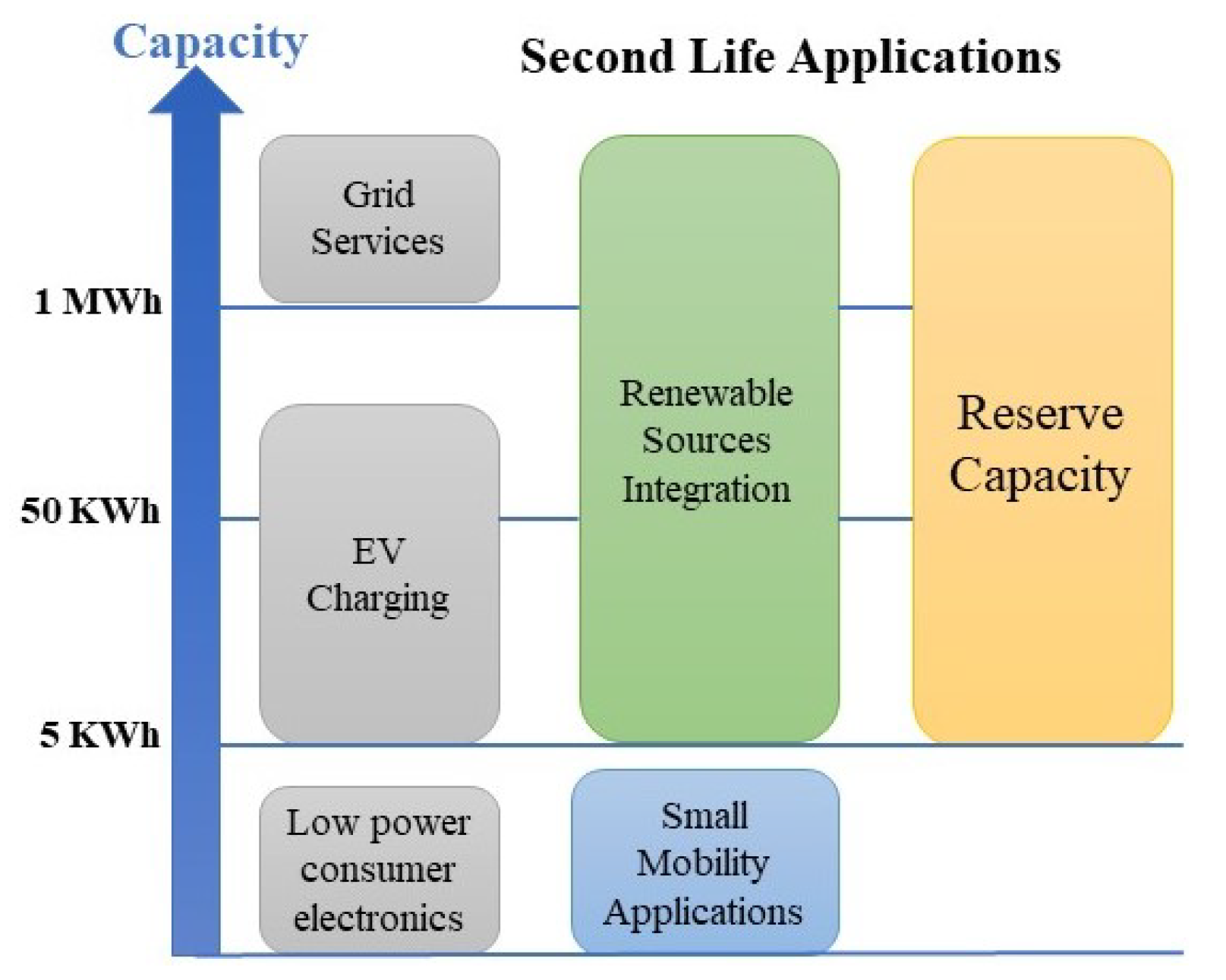
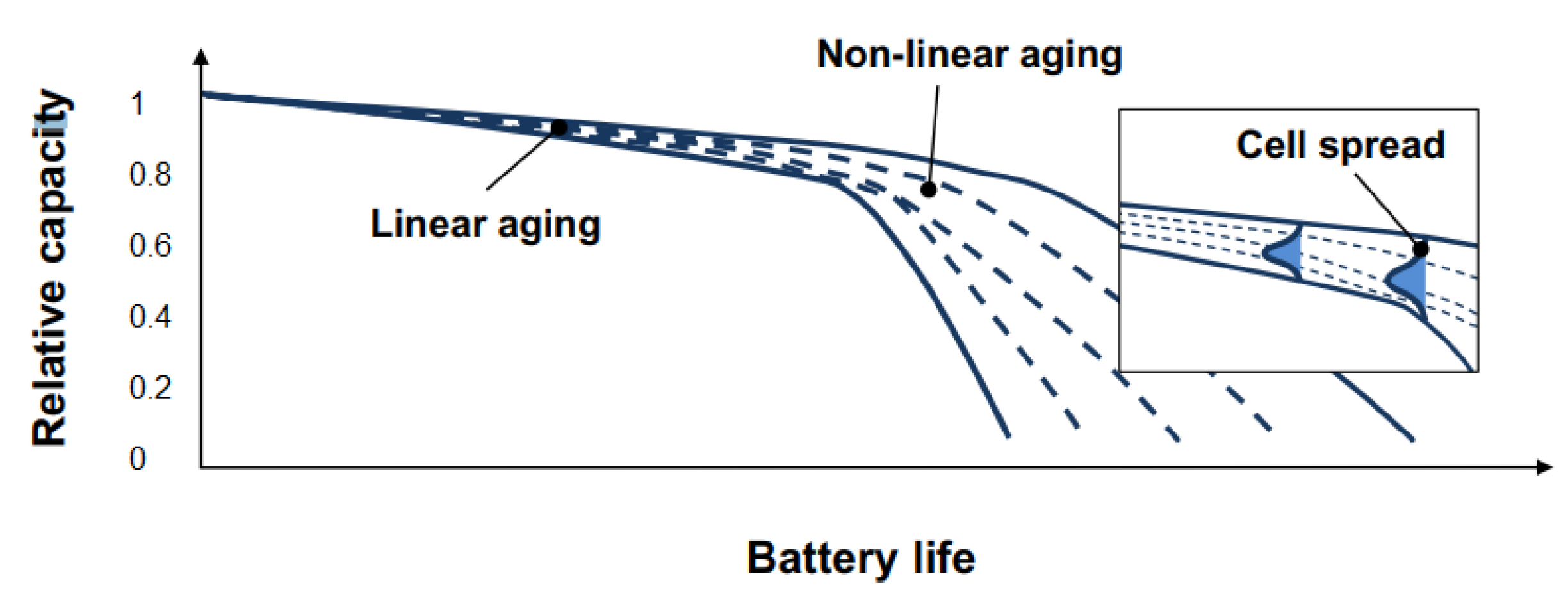

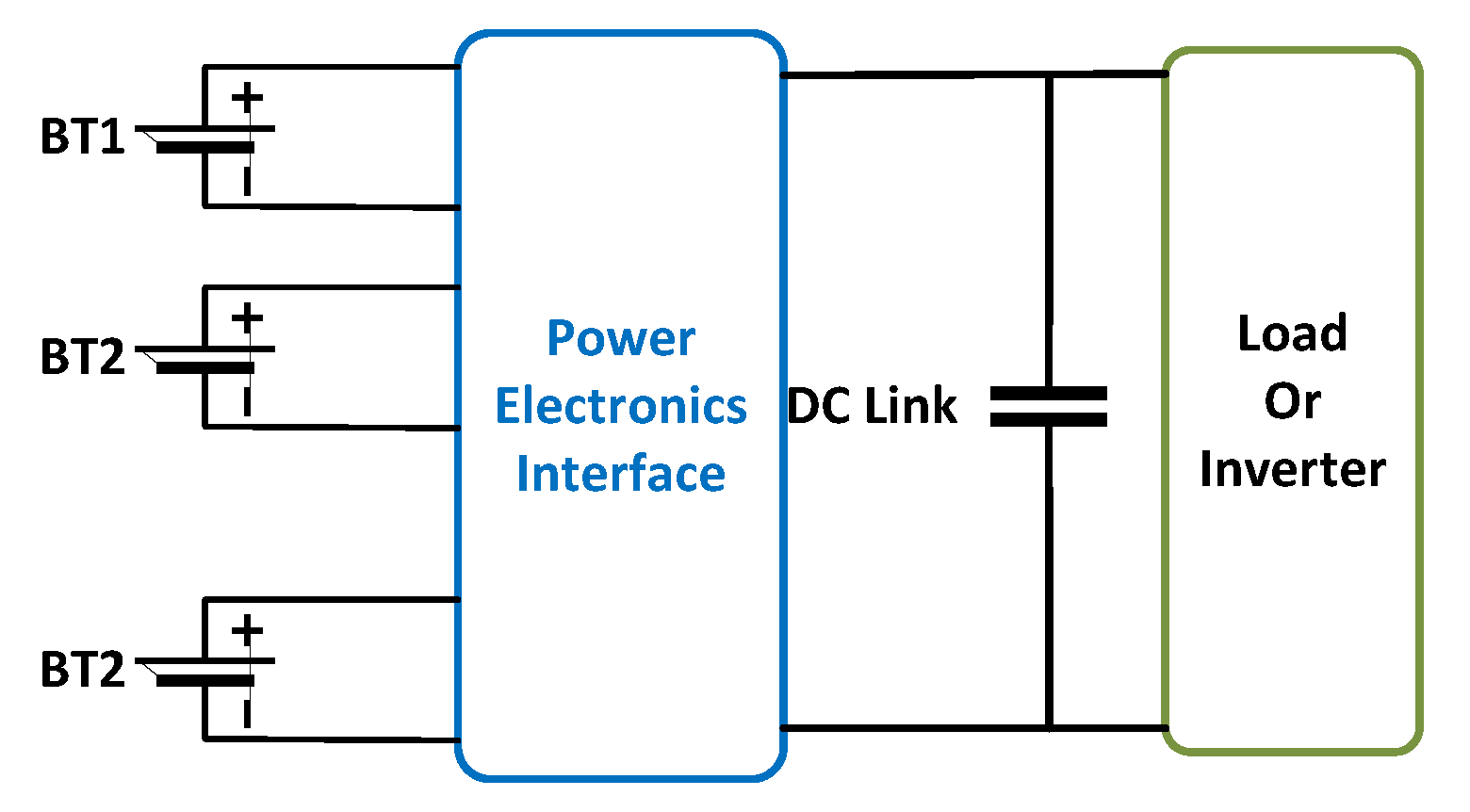
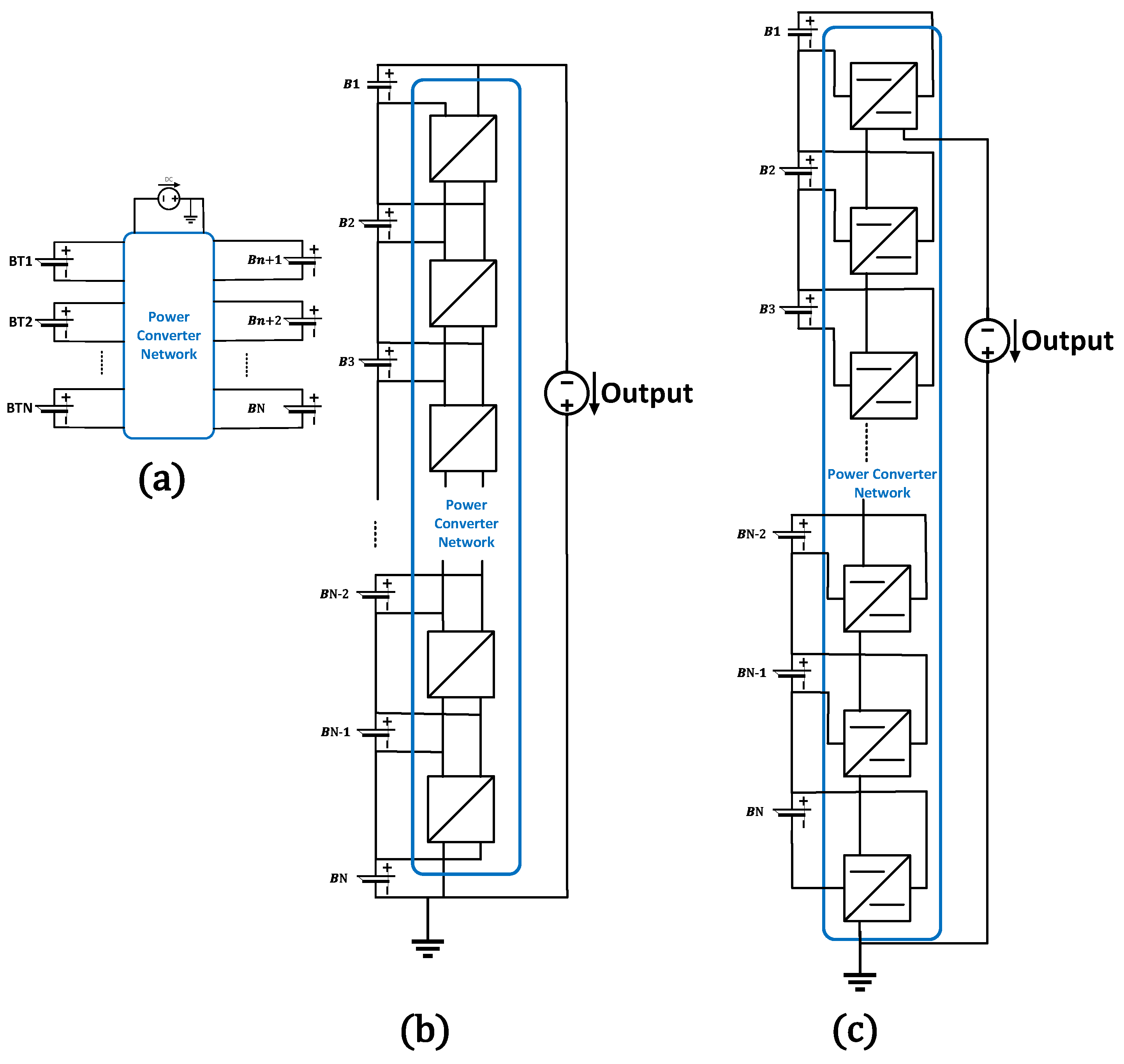
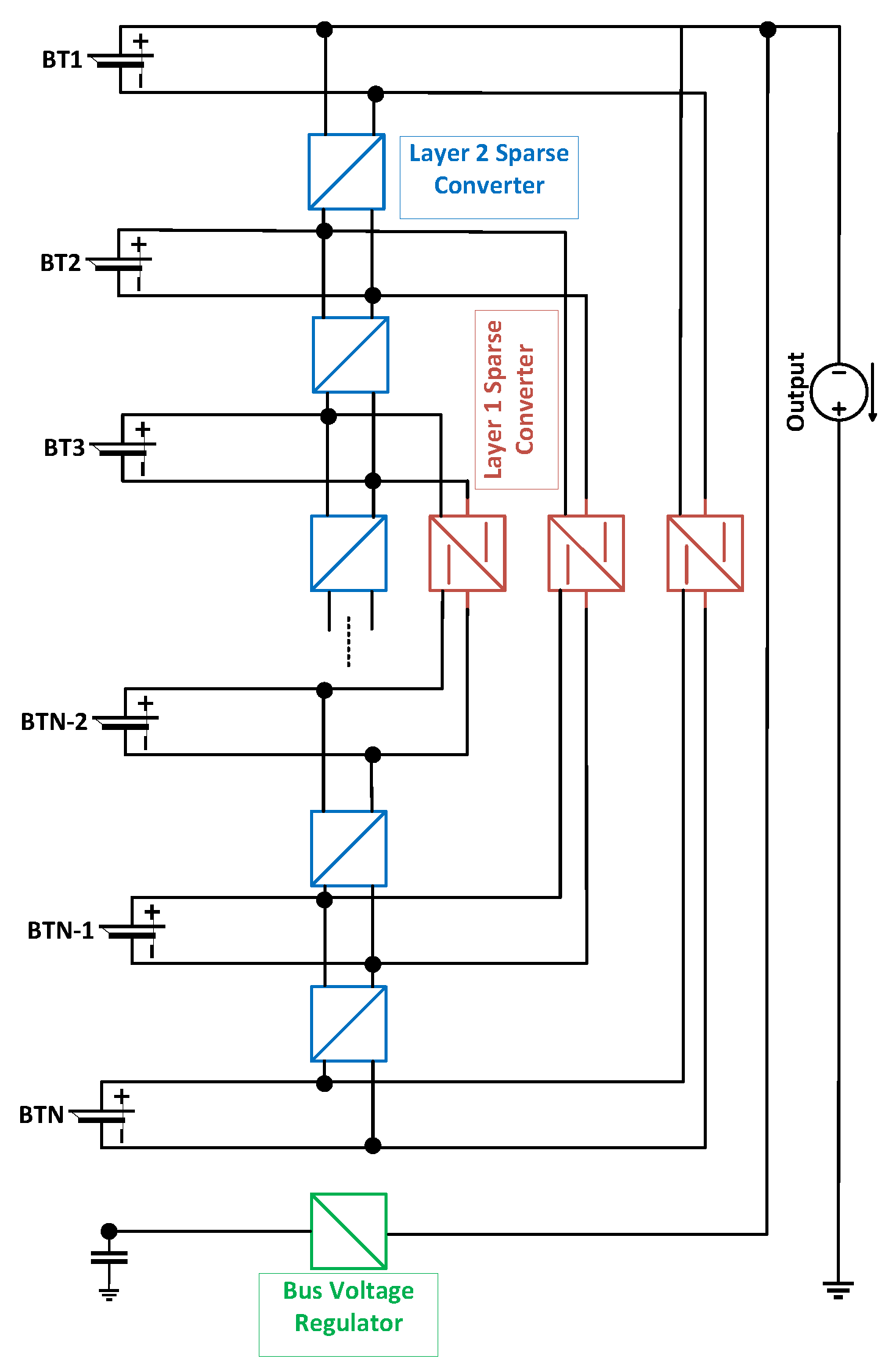


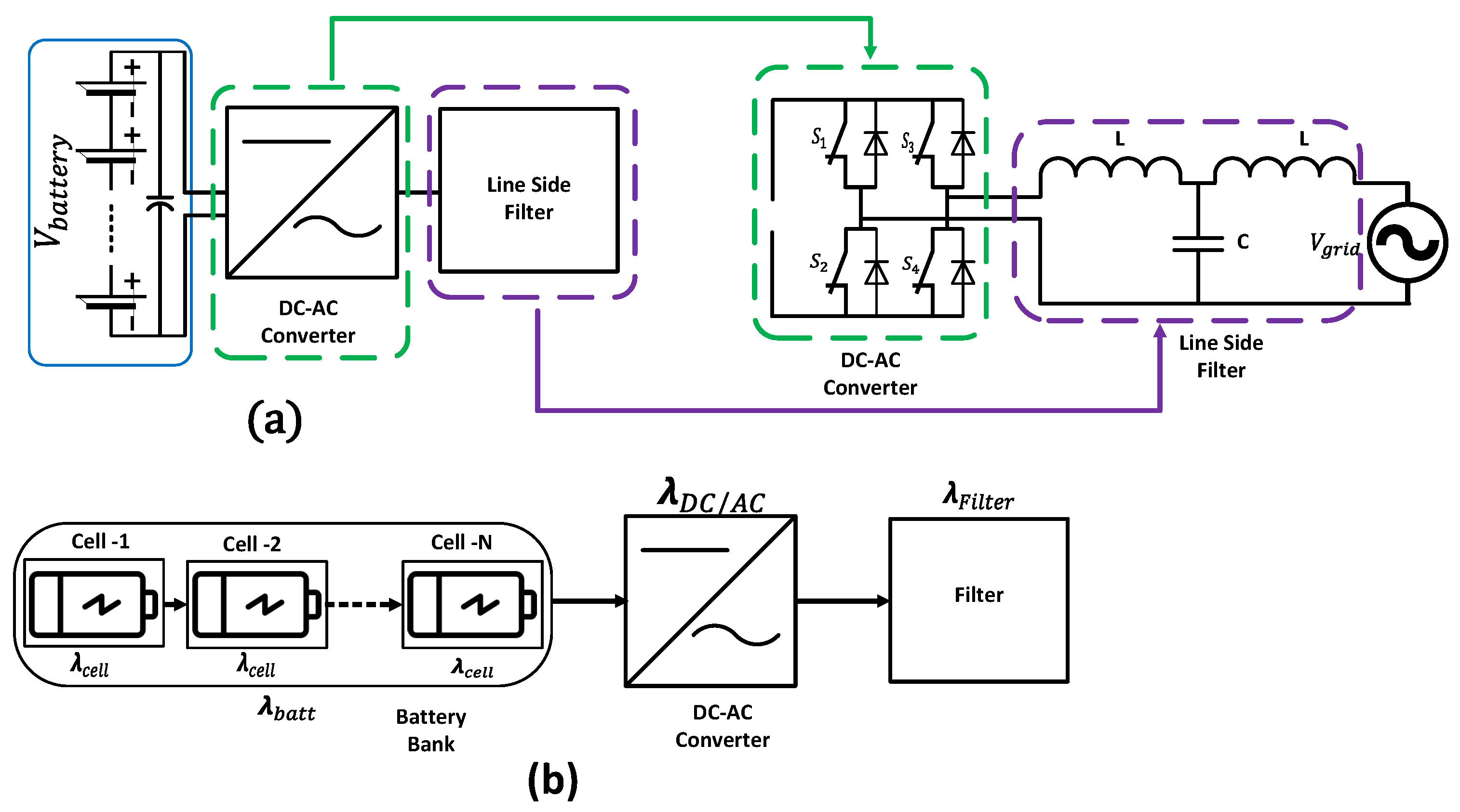
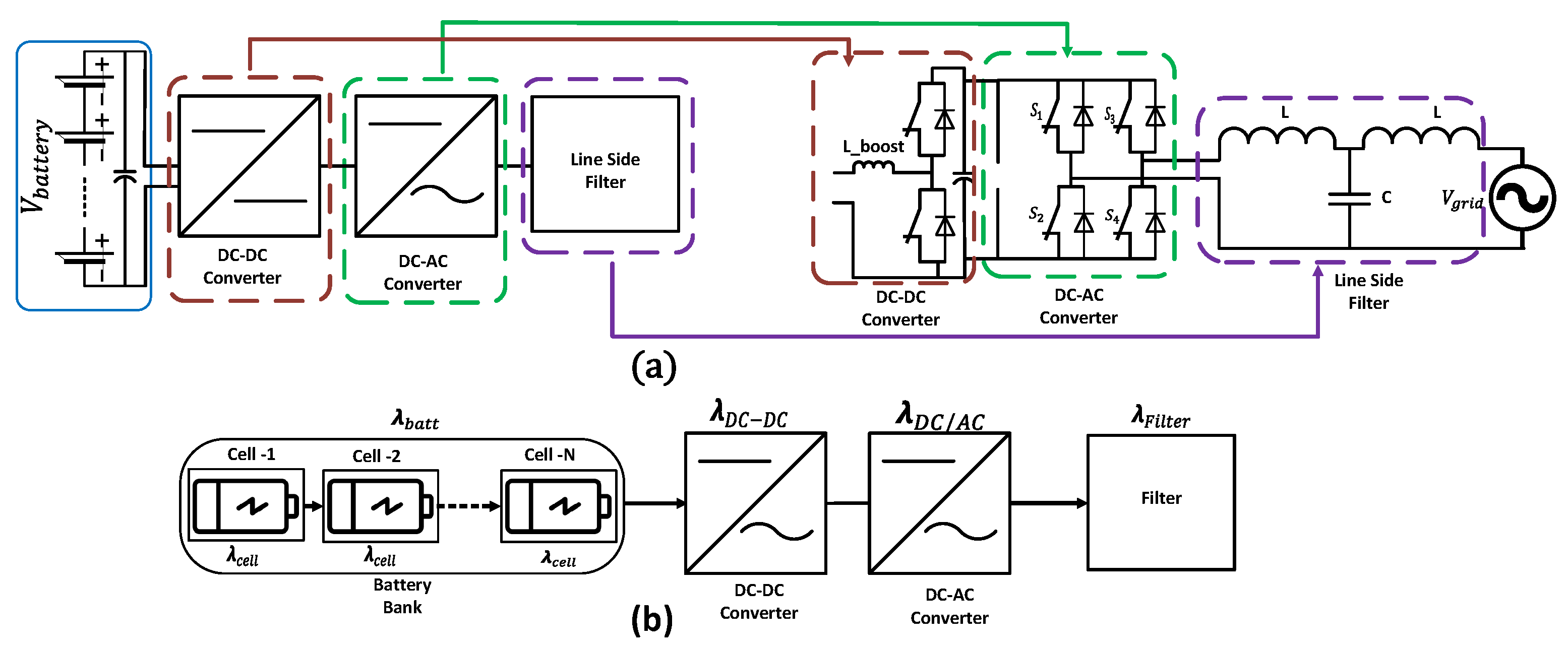
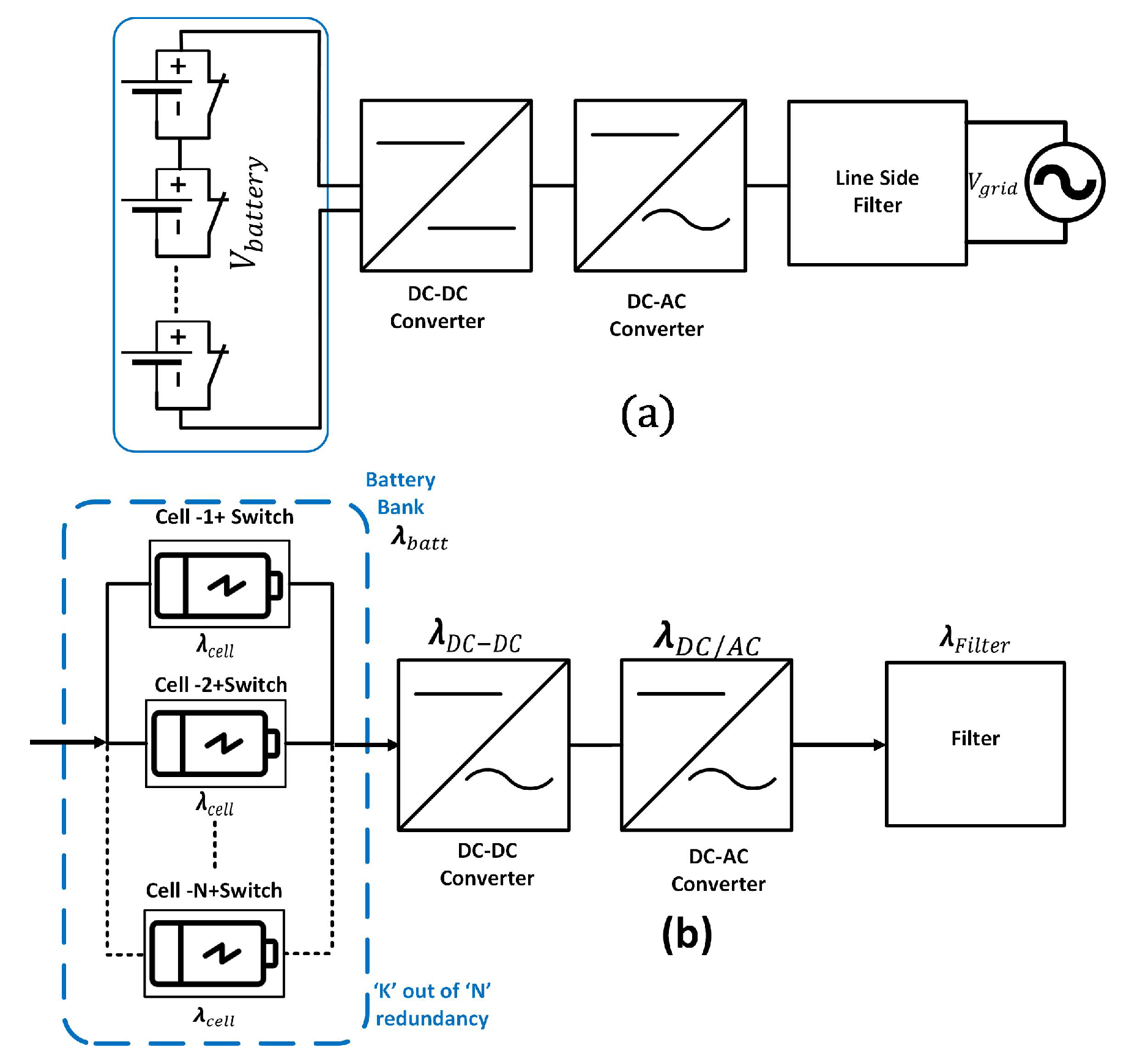

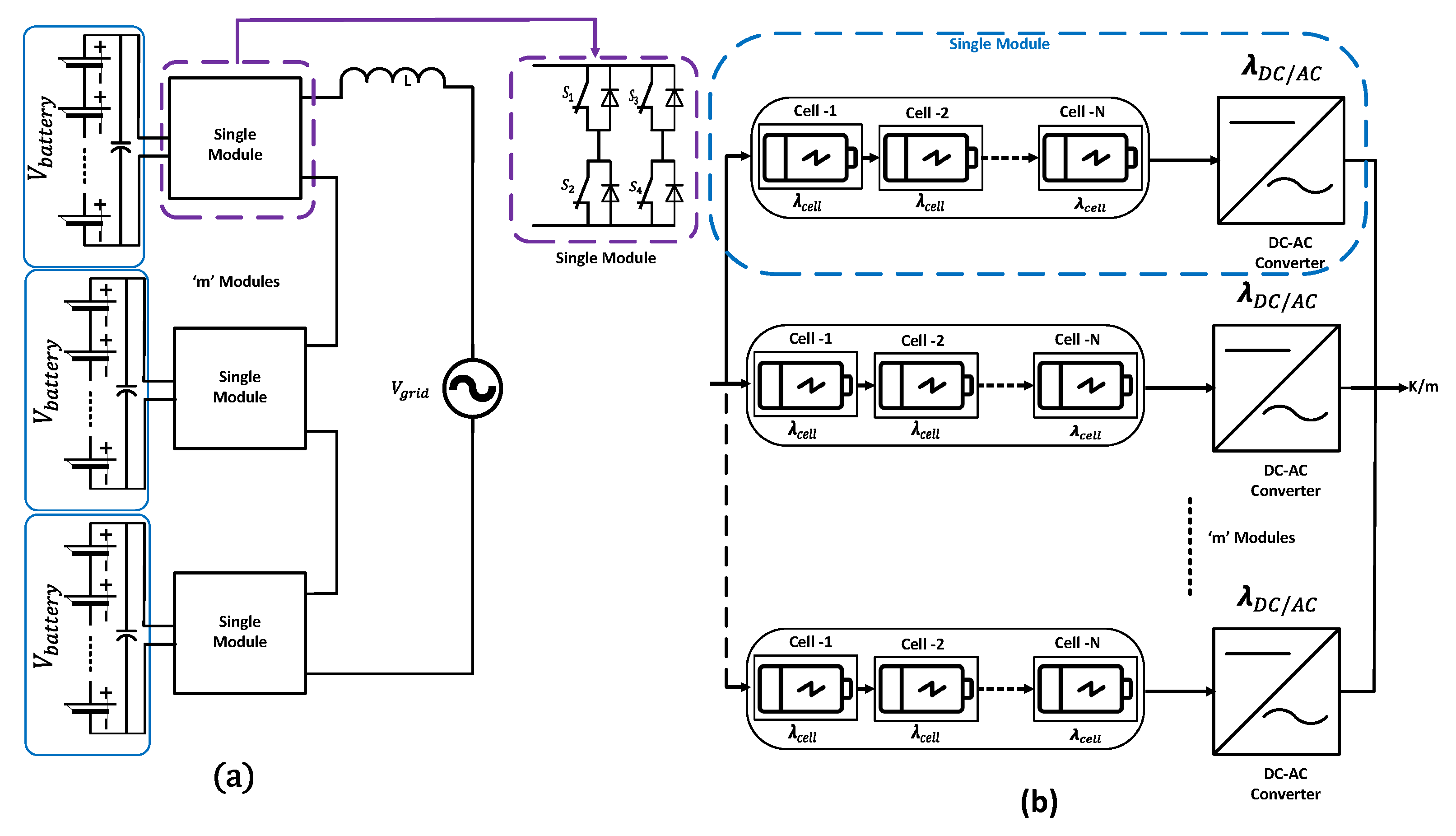

| Grid Service Type | Method/Algorithm | Hardware/Software-Based Study | Results |
|---|---|---|---|
| Power smoothing | SLB sizing using MLSERRC algorithm | Software based | One-year current profile of SLB cell [74] |
| Peak shaving | Comparative assessment of battery performance using analytical techniques | Hardware-based testing | Performance ranking of 5 different battery packs [75] |
| Frequency regulation | Cycling of battery in experimental setup | Hardware based | Thermal response and ranking of EV batteries [76] |
| Frequency containment reserve | Techno-economic framework | Software based | Economic parameters and results [77] |
| Energy arbitrage and peak shaving | PyBaMm-based degradation and optimization in Pyomo | Software based | Cell degradation and optimized revenue [79] |
| Revenue generation by arbitrage and selling capacity credits | Technoeconomic framework | Software based | Cost–benefit calculation [32] |
| Architecture | FPP | C-PPP | LS-HiPPP |
| Efficiency | 85% | 91% | 97% |
| Utilization | 100% | 81% | 95% |
| Cost | 5X | 1X | 1X |
Disclaimer/Publisher’s Note: The statements, opinions and data contained in all publications are solely those of the individual author(s) and contributor(s) and not of MDPI and/or the editor(s). MDPI and/or the editor(s) disclaim responsibility for any injury to people or property resulting from any ideas, methods, instructions or products referred to in the content. |
© 2023 by the authors. Licensee MDPI, Basel, Switzerland. This article is an open access article distributed under the terms and conditions of the Creative Commons Attribution (CC BY) license (https://creativecommons.org/licenses/by/4.0/).
Share and Cite
Hassan, A.; Khan, S.A.; Li, R.; Su, W.; Zhou, X.; Wang, M.; Wang, B. Second-Life Batteries: A Review on Power Grid Applications, Degradation Mechanisms, and Power Electronics Interface Architectures. Batteries 2023, 9, 571. https://doi.org/10.3390/batteries9120571
Hassan A, Khan SA, Li R, Su W, Zhou X, Wang M, Wang B. Second-Life Batteries: A Review on Power Grid Applications, Degradation Mechanisms, and Power Electronics Interface Architectures. Batteries. 2023; 9(12):571. https://doi.org/10.3390/batteries9120571
Chicago/Turabian StyleHassan, Ali, Shahid Aziz Khan, Rongheng Li, Wencong Su, Xuan Zhou, Mengqi Wang, and Bin Wang. 2023. "Second-Life Batteries: A Review on Power Grid Applications, Degradation Mechanisms, and Power Electronics Interface Architectures" Batteries 9, no. 12: 571. https://doi.org/10.3390/batteries9120571
APA StyleHassan, A., Khan, S. A., Li, R., Su, W., Zhou, X., Wang, M., & Wang, B. (2023). Second-Life Batteries: A Review on Power Grid Applications, Degradation Mechanisms, and Power Electronics Interface Architectures. Batteries, 9(12), 571. https://doi.org/10.3390/batteries9120571












